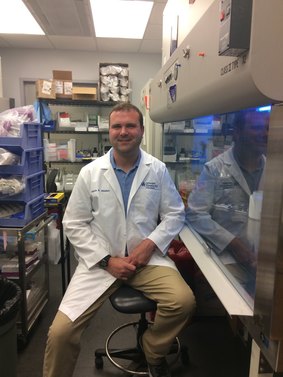
|

Marcus and Stefan,
Museo Archeologico Nazionale di Napoli, Naples, 2019 |
|
Justin Welden, Ph.D.
My project focuses on studying the regulation and function of circular RNA's deregulated in Alzheimer tissues, addressing the larger question how pre-mRNA alternative splicing and missplicing can lead to disease. We discovered that the microtubule-associated protein tau (MAPT) gene generates so far unknown circular RNAs. I am investigating the role of these circular RNAs and test whether they contribute to Tauopathies and Alzheimer's disease. The mechanism for tau pathology is not understood and the strategies employed behind our research could potentially contribute to innovative ways for a cure or preventative treatment for tauopathy related diseases. I also investigate how a snoRNA (SNORD116) contributes to Prader-Willi syndrome. Determining the role and function of SNORD116, deleted in children with Prader-Willi Syndrome, will allow us to understand the mechanism of the disease and develop an effective treatment therapy where we use an oligo that would replace the missing snoRNA. |
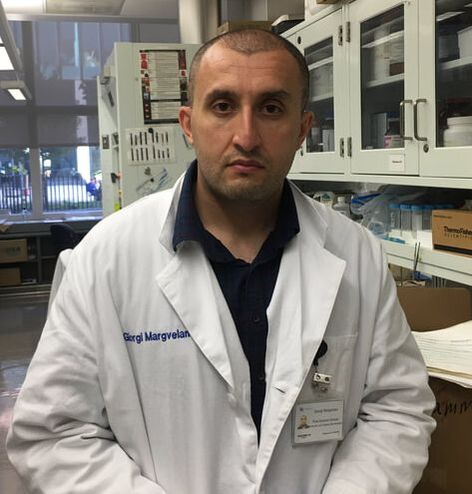
Giorgi Margvelani, Ph.D
Frontotemporal Dementia with Parkinsonism linked to chromosome 17 (FTDP-17) is an inherited brain disorder. It is characterized by the loss of neurons in frontal and temporal lobes and associated with the formation of neurofibrillary tangles containing tau (MAPT). Numerous mutation of MAPT are associated with FTDP-17. We start to study two of them that change a single amino acid (Valine, Lysine) into a start codon (Methionine). Our lab has already demonstrate that MAPT generates circRNA via back splicing of exon 12 to 10. This circRNA (12->10) harbors the two FTDP-17 mutations (K317M and V337M). Thus we hypothesize the two mutations act by initiating translation of the 12->10 human specific circRNA. I am defining the influence of FTDP-17 mutations on translatability of tau circRNA and the involvement of circRNA formed proteins on neurofibrillary tangle formation and explore treatment options.
Giorgi Margvelani e-mail
Frontotemporal Dementia with Parkinsonism linked to chromosome 17 (FTDP-17) is an inherited brain disorder. It is characterized by the loss of neurons in frontal and temporal lobes and associated with the formation of neurofibrillary tangles containing tau (MAPT). Numerous mutation of MAPT are associated with FTDP-17. We start to study two of them that change a single amino acid (Valine, Lysine) into a start codon (Methionine). Our lab has already demonstrate that MAPT generates circRNA via back splicing of exon 12 to 10. This circRNA (12->10) harbors the two FTDP-17 mutations (K317M and V337M). Thus we hypothesize the two mutations act by initiating translation of the 12->10 human specific circRNA. I am defining the influence of FTDP-17 mutations on translatability of tau circRNA and the involvement of circRNA formed proteins on neurofibrillary tangle formation and explore treatment options.
Giorgi Margvelani e-mail

Andrea Arizaca Maquera, Ms.C
My project focuses in identify molecular mechanisms that drive Alzheimer’s disease progression. I concentrated on two new forms of RNA, circular RNAs (circRNAs) and regulated retained introns. Both RNAs are changed during AD progression and several circRNAs are highly expressed and translated in entorhinal cortex. I also found a general increase in A>I editing during Alzheimer’s disease progression which likely leads to circRNA translation. Thus, circRNAs can generate new Alzheimer-specific peptides by using reading frames and/or start codons in the circular RNAs that are different from linear RNAs. This new pathomechanism creates a new ‘circRNA-specific’ proteome in Alzheimer’s Disease which in case of circMAPT contributes to Alzheimer’s disease by forming Neurofibrillary Tangles.
Andrea Arizaca e-mail
My project focuses in identify molecular mechanisms that drive Alzheimer’s disease progression. I concentrated on two new forms of RNA, circular RNAs (circRNAs) and regulated retained introns. Both RNAs are changed during AD progression and several circRNAs are highly expressed and translated in entorhinal cortex. I also found a general increase in A>I editing during Alzheimer’s disease progression which likely leads to circRNA translation. Thus, circRNAs can generate new Alzheimer-specific peptides by using reading frames and/or start codons in the circular RNAs that are different from linear RNAs. This new pathomechanism creates a new ‘circRNA-specific’ proteome in Alzheimer’s Disease which in case of circMAPT contributes to Alzheimer’s disease by forming Neurofibrillary Tangles.
Andrea Arizaca e-mail

Sandra Miranda Sardon
I study the role of SNORD116 on gene expression and also work on the detection of tau circular RNAs after their expressing cells were treated with siRNAs.
Sandra Miranda Sardon e-mail
I study the role of SNORD116 on gene expression and also work on the detection of tau circular RNAs after their expressing cells were treated with siRNAs.
Sandra Miranda Sardon e-mail
Recent Former Group Members
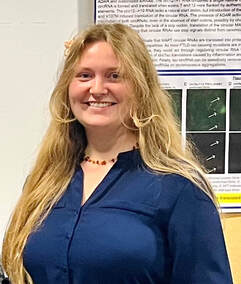
Marie Thoele
I joined Stamm's Lab for a Student Internship in the summer of 2022 for 3 months as a 4th-year medical student at the Charité Universitätsmedizin Berlin, Germany, keen to pursue laboratory research in the field of Neurology, to work on the molecular analysis of circular RNAs in Alzheimer’s disease funded by a scholarship from the German Academic Exchange Service (DAAD). During my internship, I worked on two projects: "Human circular RNA RTN4 (NOGO) as a contributor to the progression of Alzheimer’s disease“ and „The influence of the deletion of Alu elements in the formation of circular RNAs and their translation in human brain tissue“. My laboratory work involved cloning different fragments into ZKSCAN and Tau vectors using the Gibson cloning technique and KLD. I was also responsible for the preparation of the vectors and the preparation process of the clones for transfection into cell culture.
In my free time, I loved to 'discover' my new Kentucky home by hiking in Kentucky's untouched nature in the many National Parks and State Parks and by playing the piano.
Marie Thoele e-mail
I joined Stamm's Lab for a Student Internship in the summer of 2022 for 3 months as a 4th-year medical student at the Charité Universitätsmedizin Berlin, Germany, keen to pursue laboratory research in the field of Neurology, to work on the molecular analysis of circular RNAs in Alzheimer’s disease funded by a scholarship from the German Academic Exchange Service (DAAD). During my internship, I worked on two projects: "Human circular RNA RTN4 (NOGO) as a contributor to the progression of Alzheimer’s disease“ and „The influence of the deletion of Alu elements in the formation of circular RNAs and their translation in human brain tissue“. My laboratory work involved cloning different fragments into ZKSCAN and Tau vectors using the Gibson cloning technique and KLD. I was also responsible for the preparation of the vectors and the preparation process of the clones for transfection into cell culture.
In my free time, I loved to 'discover' my new Kentucky home by hiking in Kentucky's untouched nature in the many National Parks and State Parks and by playing the piano.
Marie Thoele e-mail
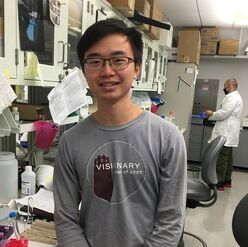

Bhavani Gudlavalleti

Samantha Danyi
I am focusing on the spasticity of muscles and deregulation of motoneurons after spinal cord injury, and how the serotonin receptor 5HT2c is responsible for this. I am using splice-site changing oligonucleotides that our lab created to target the serotonin receptor 2C to reduce spasticity after spinal cord injury. It has been previously determined that after a spinal cord injury, the amount of the truncated and full-length isoforms of the serotonin receptor will change caudal to the injury site. The serotonin receptor 2c is located in the central nervous system and is largely responsible for the regulation of muscle tone and motoneurons, and its absence causes paralysis, so to study its deregulation we perform transections of rat spinal cords at the S2 location and inject the oligos intrathecally. Determining the alternative splicing patterns of the serotonin receptor caudal to the injury site and identifying oligos that regulate this splicing will lead to the development of a therapeutic drug to reduce spasticity after spinal cord injury.
I am focusing on the spasticity of muscles and deregulation of motoneurons after spinal cord injury, and how the serotonin receptor 5HT2c is responsible for this. I am using splice-site changing oligonucleotides that our lab created to target the serotonin receptor 2C to reduce spasticity after spinal cord injury. It has been previously determined that after a spinal cord injury, the amount of the truncated and full-length isoforms of the serotonin receptor will change caudal to the injury site. The serotonin receptor 2c is located in the central nervous system and is largely responsible for the regulation of muscle tone and motoneurons, and its absence causes paralysis, so to study its deregulation we perform transections of rat spinal cords at the S2 location and inject the oligos intrathecally. Determining the alternative splicing patterns of the serotonin receptor caudal to the injury site and identifying oligos that regulate this splicing will lead to the development of a therapeutic drug to reduce spasticity after spinal cord injury.
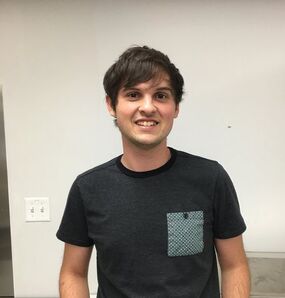

Anna Pawluchin
I worked as an intern in summer 2018 on tau circular RNAs. My work was financed by a fellowship from the German academic exchange service (DAAD). During my internship I worked on two different projects. The first one concentrated on the protein Tau in connection with Tau-related diseases called tauopathies. I cloned minigenes to express circular RNAs in cell culture and in fish to find out whether they are expressed as long proteins an contribute to Tau accumulations in the brain. The other project I worked on focused on the small nucleolar RNA SNORD116 and its connection to Prader-Willi syndrome. Therefore, I tried to establish a stable SNORD116 knock out cell line using CRISPR/CAS9 to look closer at the function of this snoRNA.
I worked as an intern in summer 2018 on tau circular RNAs. My work was financed by a fellowship from the German academic exchange service (DAAD). During my internship I worked on two different projects. The first one concentrated on the protein Tau in connection with Tau-related diseases called tauopathies. I cloned minigenes to express circular RNAs in cell culture and in fish to find out whether they are expressed as long proteins an contribute to Tau accumulations in the brain. The other project I worked on focused on the small nucleolar RNA SNORD116 and its connection to Prader-Willi syndrome. Therefore, I tried to establish a stable SNORD116 knock out cell line using CRISPR/CAS9 to look closer at the function of this snoRNA.

Jay Van Doorn,
B. Sc.
I am investigating various circular RNAs endogenously generated within human brain tissue, especially the potential relationship between these RNA isoforms and degenerative tauopathies. This includes finding and isolating the RNA isoforms, sequencing them, recreating them in vitro, as well as determining the effect of endogenous alternative splicing regulators on the generation of these circular RNAs. These results could lead to new perspectives on the degradation processes and detection of several neurological diseases.
B. Sc.
I am investigating various circular RNAs endogenously generated within human brain tissue, especially the potential relationship between these RNA isoforms and degenerative tauopathies. This includes finding and isolating the RNA isoforms, sequencing them, recreating them in vitro, as well as determining the effect of endogenous alternative splicing regulators on the generation of these circular RNAs. These results could lead to new perspectives on the degradation processes and detection of several neurological diseases.

Patrick Cordero
The project on which I am currently contributing involves determining the mechanism of a small nucleolar RNA called SNORD116. SNORD116 affects the alternative splicing of multiple genes which are highly expressed in the brain. The proposed mechanism of SNORD116 which is being investigated in this project is that SNORD116 competes with proteins, such as HuR, that bind to intronic splicing silencers, thus promoting the inclusion of microexons. My current task involves generating minigenes from genes which have been shown to have changes in alternative splicing due to the knockdown of SNORD116. These minigenes will be used to analyze RNA interaction, the possible competition between HuR and SNORD116, the effects of overexpression and knockdown of SNORD116, and the effects of factors binding to SNORD116. The results of this research are important because they may give insight into the molecular mechanism of diseases associated with the dysregulation of SNORD116 such as autism and Prader-Willi syndrome. (2018-2019)
I am now off to Medical School.
The project on which I am currently contributing involves determining the mechanism of a small nucleolar RNA called SNORD116. SNORD116 affects the alternative splicing of multiple genes which are highly expressed in the brain. The proposed mechanism of SNORD116 which is being investigated in this project is that SNORD116 competes with proteins, such as HuR, that bind to intronic splicing silencers, thus promoting the inclusion of microexons. My current task involves generating minigenes from genes which have been shown to have changes in alternative splicing due to the knockdown of SNORD116. These minigenes will be used to analyze RNA interaction, the possible competition between HuR and SNORD116, the effects of overexpression and knockdown of SNORD116, and the effects of factors binding to SNORD116. The results of this research are important because they may give insight into the molecular mechanism of diseases associated with the dysregulation of SNORD116 such as autism and Prader-Willi syndrome. (2018-2019)
I am now off to Medical School.

Liying Wu
I joined the lab in july 2019 and work on the role of SNORD116 in gene regulation, in addition to my tasks as a lab technician. In 2020 I joined UCLA as a graduate student.
I joined the lab in july 2019 and work on the role of SNORD116 in gene regulation, in addition to my tasks as a lab technician. In 2020 I joined UCLA as a graduate student.

Kaden M. Cummins
I am an undergraduate student at the University of Kentucky in the College of Agriculture, Food, and Environment pursuing a Bachelor of Science in Agricultural and Medical Biotechnology. I currently work in the Stamm Lab as a lab technician. I am investigating the potential role that circular tau RNAs play in neurodegenerative diseases associated with tau pathology. I am learning how to generate different expression constructs that express circular tau RNAs, different cloning techniques, and Gibson and mutagenic cloning, to better understand how mutations in the tau locus lead to tauopathies. I have made mutagenic clones that mimic FTDP-17 (Frontotemporal Dementia and Parkinsonism) and will test these constructs in cell culture. The majority of the mutations lie in the circular RNA region, where the disease mechanism could act on the circular RNAs. Two mutations create start codons in the circular RNAs and allow translation to occur in a rolling fashion, which could form multimers that promote tau aggregation and neurofibrillary tau tangles. Our goal is to understand the function of the circular tau RNAs and the role they may play in disease. This research will pave the way to better understand tauopathy related diseases.
I am an undergraduate student at the University of Kentucky in the College of Agriculture, Food, and Environment pursuing a Bachelor of Science in Agricultural and Medical Biotechnology. I currently work in the Stamm Lab as a lab technician. I am investigating the potential role that circular tau RNAs play in neurodegenerative diseases associated with tau pathology. I am learning how to generate different expression constructs that express circular tau RNAs, different cloning techniques, and Gibson and mutagenic cloning, to better understand how mutations in the tau locus lead to tauopathies. I have made mutagenic clones that mimic FTDP-17 (Frontotemporal Dementia and Parkinsonism) and will test these constructs in cell culture. The majority of the mutations lie in the circular RNA region, where the disease mechanism could act on the circular RNAs. Two mutations create start codons in the circular RNAs and allow translation to occur in a rolling fashion, which could form multimers that promote tau aggregation and neurofibrillary tau tangles. Our goal is to understand the function of the circular tau RNAs and the role they may play in disease. This research will pave the way to better understand tauopathy related diseases.
Old group photos
|
|
|
Former students and their Doctoral Theses
- Justin R. Welden, "Cloning and Functional Characterizations of Circular RNAs from the Human MAPT Locus", University of Kentucky, 2021
- Olga Kelemen, “The role of tra2-beta1 in regulation of alternative splicing and translation”, University of Erlangen (2013)
- Amit Khanna, “The snoRNAs MBII-52 and MBII-85 are processed into smaller RNAs and regulate alternative splicing”, University of Erlangen (2010)
- Chiranthani Sumanasekera, “Regulation of Alternative splicing by C6 Pyridinium Ceramide”, University of Kentucky (2009)
- Natalya Benderska “Signal dependency of Tra2-beta1 alternative splicing”, University of Erlangen, Germany (2008)
- Yesheng Tang: “Function of splicing factor Tra2-beta1 in alternative splicing and Translation”, University of Erlangen, Germany (2008)
- Bettina Heinrich: “Characterization of heterogeneous nuclear ribonucleoprotein G (hnRNP G) and its role in splice site selection”, University of Erlangen, Germany (2007)
- Zhaiyi Zhang: “Characterization of YT521-B, a novel RNA binding protein regulated by tyrosine phosphorylation”, University of Erlangen, Germany (2007)
- Tatyana Novoyatleva: “Regulation of alternative splice site selection by reversible protein phosphorylation”, University of Erlangen, Germany (2006)
- Helen Hager (Diplom, 2007)
- Jingyi Hui (Post Doc,2006)
- Shivendra Kishore: “The snoRNA HBII-52 absent in Prader-Willi syndrome patients regulates the alternative splicing of the serotonin receptor 5-HT2CR" University of Erlangen, Germany (2006)
- Ilona Rafalska, “The RNA-bindng protein YT521-B plays a role in the alternative splice site selection and is regulated by tyrosine phosphorylation”, University of Erlangen, Germany (2005)
- Annette M. Hartmann, "Regulation of alternative splicing of Tau Exon 10", Ludwig-Maximilian University, Munich (2003)
- Peter Stoilov, “Regulation of tra2-beta alternative splicing”, University of Erlangen, Germany, Currently Assistant Professor, University of West Virginia (2002)
- Oliver Stoss, "Characterization of novel proteins that regulate alternative splicing", Ludwig-Maximilian University, Munich (2000)
- Rossette Daoud, "Influence of neuronal activity on alternative splicing pathways in the rat brain", Ludwig-Maximilian University, Munich (1999)
- Birgit Beil, "Funktionelle Klonierung und Charakterisierung zwei neuer menschlicher Kernproteine", Ludwig-Maximilian University, Munich (1999)
